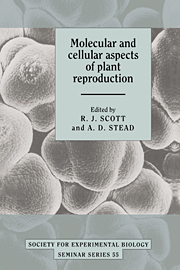Book contents
- Frontmatter
- Contents
- List of Contributors
- Introduction: ‘Where do we go from here?’
- Molecular control of floral organogenesis and plant reproduction in Petunia hybrida
- Control of floral morphogenesis in cauliflower (Brassica oleracea L. var. botrytis): the role of homeotic genes
- Isolation and properties of mutants of Arabidopsis thaliana with reduced sensitivity to short days
- Asexual mutants in Melandrium album (Silene alba): tools in cDNA cloning and analysis of an X/Y chromosome system in plants
- Pollen exine – the sporopollenin enigma and the physics of pattern
- The diversity and regulation of gene expression in the pathway of male gametophyte development
- Characterisation of Arabidopsis thaliana anther-specific gene which shares sequence similarity with β-1,3-glucanases
- Ovule cDNA clones of Petunia hybrida encoding proteins homologous to MAP and shaggy/zeste-white 3 protein kinases
- Towards the elucidation of the mechanisms of pollen tube inhibition during the self-incompatibility response in Papaver rhoeas
- Intracellular movement and pollen physiology: progress and prospects
- Organisation and functions of cell surface molecules on gametes of the brown algae Fucus
- Strategies of flower senescence – a review
- The physiology of petal senescence which is not initiated by ethylene
- Molecular biology of flower senescence in carnation
- Ethylene sensitivity and flower senescence
- Ethylene biosynthetic genes and inter-organ signalling during flower senescence
- Index
Ethylene sensitivity and flower senescence
Published online by Cambridge University Press: 04 August 2010
- Frontmatter
- Contents
- List of Contributors
- Introduction: ‘Where do we go from here?’
- Molecular control of floral organogenesis and plant reproduction in Petunia hybrida
- Control of floral morphogenesis in cauliflower (Brassica oleracea L. var. botrytis): the role of homeotic genes
- Isolation and properties of mutants of Arabidopsis thaliana with reduced sensitivity to short days
- Asexual mutants in Melandrium album (Silene alba): tools in cDNA cloning and analysis of an X/Y chromosome system in plants
- Pollen exine – the sporopollenin enigma and the physics of pattern
- The diversity and regulation of gene expression in the pathway of male gametophyte development
- Characterisation of Arabidopsis thaliana anther-specific gene which shares sequence similarity with β-1,3-glucanases
- Ovule cDNA clones of Petunia hybrida encoding proteins homologous to MAP and shaggy/zeste-white 3 protein kinases
- Towards the elucidation of the mechanisms of pollen tube inhibition during the self-incompatibility response in Papaver rhoeas
- Intracellular movement and pollen physiology: progress and prospects
- Organisation and functions of cell surface molecules on gametes of the brown algae Fucus
- Strategies of flower senescence – a review
- The physiology of petal senescence which is not initiated by ethylene
- Molecular biology of flower senescence in carnation
- Ethylene sensitivity and flower senescence
- Ethylene biosynthetic genes and inter-organ signalling during flower senescence
- Index
Summary
Introduction
The hormonal theory of plant growth substances states that growth substances are limiting and, therefore, regulatory factors in plant growth and development. However, renewed interest in the role of the sensitivity of plant tissues to growth substances in growth and development was sparked of by a series of articles by Trewavas and his co-workers during the early 1980s (Trewavas, 1981, 1982; Trewavas & Jones, 1981). These articles pointed to the inadequacies of the hormonal theory, and emphasised the importance of sensitivity to growth substances as the primary limiting factor in the control of growth and development by these growth substances. The presence of both the growth substance and its receptor molecule is required for a biological response to occur. Since a biological response is caused by a receptor/growth substance complex, the response is dependent on the concentration of the growth substance as advocated by the hormonal theory. It is obvious that, if receptor availibility changes during growth and development, measurements of changes in growth substance concentration on its own has limited value.
The development of sensitivity to growth substances such as auxins, cytokinins and ethylene appears to precede the developmental process which it induces (Trewavas, 1982; Whitehead & Vasiljevic, 1993). In many flowers, ethylene plays an important role in the initiation and regulation of the processes that accompany corolla senescence.
- Type
- Chapter
- Information
- Molecular and Cellular Aspects of Plant Reproduction , pp. 269 - 284Publisher: Cambridge University PressPrint publication year: 1994
- 5
- Cited by



